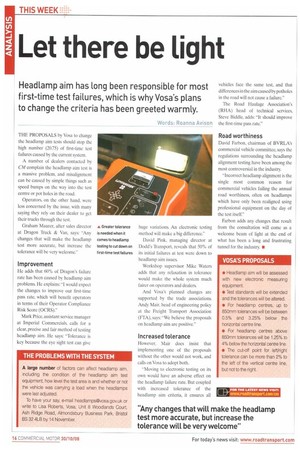1 THIS WEEK
Page 16

If you've noticed an error in this article please click here to report it so we can fix it.
Let there be light
Headlamp aim has long been responsible for most first-time test failures, which is why Vosa's plans to change the criteria has been greeted warmly.
Words: Roanna Avison
THE PROPOSALS by Vasa to change the headlamp aim tests should stop the high number (20.75) of first-time test failures caused by the current system.
A number of dealers contacted by CM complain the headlamp aim test is a massive problem, and misalignment can be caused by simple things such as speed bumps on the way into the test centre or pot holes in the road.
Operators, on the other hand, were less concerned by the issue, with many saying they rely on their dealer to get their trucks through the test.
Graham Maurer, after sales director at Dragon Truck & Van, says: "Any changes that will make the headlamp test more accurate, but increase the tolerance will be very welcome.
Improvement
He adds that 60% of Dragon's failure rate has been caused by headlamp aim problems He explains: "I would expect the changes to improve our first-time pass rate, which will benefit operators in terms of their Operator Compliance Risk Score (OCRS)."
Mark Price, assistant service manager at Imperial Commercials, calls for a clear, precise and fair method of testing headlamp aim. He says: "Tolerance is key because the eye sight test can give huge variations. An electronic testing method will make a big difference."
David Pink, managing director at Dodd's Transport, reveals that 50% of its initial failures at test were down to headlamp aim issues.
Workshop supervisor Mike Waters adds that any relaxation in tolerance would make the whole system much fairer on operators and dealers.
And Vosa's planned changes are supported by the trade associations. Andy Mair, head of engineering policy at the Freight Transport Association (FTA), says: "We believe the proposals on headlamp aim are positive."
Increased tolerance
However, Mair does insist that implementing one of the proposals without the other would not work, and calls on Vosa to adopt both.
"Moving to electronic testing on its own would have an adverse effect on the headlamp failure rate. But coupled with increased tolerance of the headlamp aim criteria, it ensures all vehicles face the same test, and that differences in the aim caused by potholes in the road will not cause a failure."
The Road Haulage Association's (RHA) head of technical services, Steve Biddle, adds: "It should improve the first-time pass rate."
Road worthiness
David Farbon, chairman of BVRLA's commercial vehicle committee, says the regulations surrounding the headlamp alignment testing have been among the most controversial in the industry.
"Incorrect headlamp alignment is the single most common reason for commercial vehicles failing the annual road worthiness, often on headlamps which have only been realigned using professional equipment on the day of the test itself."
Farbon adds any changes that result from the consultation will come as a welcome beam of light at the end of what has been a long and frustrating tunnel for the industry. •




































































































































































